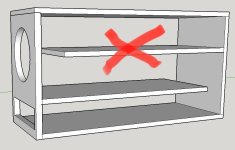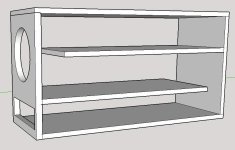Ahoy!
I am trying my hand at designing a tapped horn for the Dayton Audio MX12-22. I've built Cubo subs and designed sealed subs, but this is my first attempt at designing a tapped horn.
The horn will be used as part of a small PA for bass heavy electronic music.
My initial design goal was to get something pretty flat between 30 and 80Hz with a 12" driver.
Plugging some numbers into hornresp I got the attached power response. It is very flat from 27-74Hz hanging out at a steady 93.7dB@1W. At 24Hz it is still 90.7dB.
A bit more concern is the peaks above 80Hz. It is at 94dB @ 76Hz but already up to 97.4dB by 81.85Hz. By perhaps I will be fine if I set my crossover frequency closer to 76Hz? Alternatively -- could I EQ those peaks down and get a response up to 133

I am used to seeing valleys right above the cutoff frequency instead of peaks. So I am not sure what to think. The response curve below 76Hz is delightfully flat looking though.
I have also attached the Phase Response. I have no idea what a health phase response for a TH normally looks like.

Here are the Input Parameters.

Does this look like a promising start or should I abandon ship now? I haven't bought anything yet, so I am not committed to using these drivers. I have not tried folding the box yet. No point in designing a box if the model is bad.
thanks!
I am trying my hand at designing a tapped horn for the Dayton Audio MX12-22. I've built Cubo subs and designed sealed subs, but this is my first attempt at designing a tapped horn.
The horn will be used as part of a small PA for bass heavy electronic music.
My initial design goal was to get something pretty flat between 30 and 80Hz with a 12" driver.
Plugging some numbers into hornresp I got the attached power response. It is very flat from 27-74Hz hanging out at a steady 93.7dB@1W. At 24Hz it is still 90.7dB.
A bit more concern is the peaks above 80Hz. It is at 94dB @ 76Hz but already up to 97.4dB by 81.85Hz. By perhaps I will be fine if I set my crossover frequency closer to 76Hz? Alternatively -- could I EQ those peaks down and get a response up to 133
I am used to seeing valleys right above the cutoff frequency instead of peaks. So I am not sure what to think. The response curve below 76Hz is delightfully flat looking though.
I have also attached the Phase Response. I have no idea what a health phase response for a TH normally looks like.
Here are the Input Parameters.
Does this look like a promising start or should I abandon ship now? I haven't bought anything yet, so I am not committed to using these drivers. I have not tried folding the box yet. No point in designing a box if the model is bad.
thanks!
Your TH phase response looks normal for "standard wrapped phase". Using the "Delay" tool you can use the "Offset Delay Correction" set to a default or user specified delay to unwrap it. Your

The compression ratio of Sd to S2 is almost 5/1, going much over 2/1 with high power /high excursion is probably not a good idea, the cone may start to fold up or distort badly before reaching Xmax.
VTC is set to "0", the curvature of the cone will add some volume there- not a big deal, but can affect the compression ratio.
The peaks above 80Hz could be equalized.
Your driver is nominally 4 ohms, so 2.83 volts is two watts, not one. That puts the cabinet somewhere under 120 dB at 600 watts..
The Dayton Audio MX12-22 Xmax 15.5 mm, XBL (Klippel verified excursion @ 70% BL) 18.8 mm, while power is 600 watts.
Check excursion and power/voltage to see which is the limiting factor, bass heavy electronic music often has a very low crest factor and the 2.5" voice coil may cook before reaching excursion limits.
Also try a model of a bass reflex to compare whether the size penalty of a TH is worth the gain- your cabinet is going to use a lot of plywood for a single 12".
Art
The compression ratio of Sd to S2 is almost 5/1, going much over 2/1 with high power /high excursion is probably not a good idea, the cone may start to fold up or distort badly before reaching Xmax.
VTC is set to "0", the curvature of the cone will add some volume there- not a big deal, but can affect the compression ratio.
The peaks above 80Hz could be equalized.
Your driver is nominally 4 ohms, so 2.83 volts is two watts, not one. That puts the cabinet somewhere under 120 dB at 600 watts..
The Dayton Audio MX12-22 Xmax 15.5 mm, XBL (Klippel verified excursion @ 70% BL) 18.8 mm, while power is 600 watts.
Check excursion and power/voltage to see which is the limiting factor, bass heavy electronic music often has a very low crest factor and the 2.5" voice coil may cook before reaching excursion limits.
Also try a model of a bass reflex to compare whether the size penalty of a TH is worth the gain- your cabinet is going to use a lot of plywood for a single 12".
Art
Thanks. Back to the drawing board.
I will play with some other drivers and look more into how to set Vtc.
One problem I have with tapped horns (and related) is that drivers are typically mounted with the magnets in the mouth. That seems great for helping keep the motor cool, but terrible when it comes to protection from rain the other elements. I know that in some designs (like the Cubo Sub) the driver can be flipped the other way so the magnet is protected inside the box, but it is unclear how to model the effects of doing that. Is that where Vtc might come into play?
How do people normally protect their drivers from rain? In the past I have made rain covers -- but it doesn't seem elegant.
I was thinking that if I used a driver with an aluminum cone and rubber surround, then water would be less of an issues -- especially if the magnet is protected inside the box. But I have not found a suitable driver with those specifications.
How do I determine my minimum box width? I am constrained in width, but not height. Obviously it has to be wide enough to mount the driver. But, how much extra width do I need? Based on what I have read, it seems that the width of the box is often determined by external factors such as being able to fit them side-by-side into a moving truck, etc. Is the width not all that important as long as you can reasonably design the box and hit your S1-S4 values using that width?
Thanks!
I will play with some other drivers and look more into how to set Vtc.
One problem I have with tapped horns (and related) is that drivers are typically mounted with the magnets in the mouth. That seems great for helping keep the motor cool, but terrible when it comes to protection from rain the other elements. I know that in some designs (like the Cubo Sub) the driver can be flipped the other way so the magnet is protected inside the box, but it is unclear how to model the effects of doing that. Is that where Vtc might come into play?
How do people normally protect their drivers from rain? In the past I have made rain covers -- but it doesn't seem elegant.
I was thinking that if I used a driver with an aluminum cone and rubber surround, then water would be less of an issues -- especially if the magnet is protected inside the box. But I have not found a suitable driver with those specifications.
How do I determine my minimum box width? I am constrained in width, but not height. Obviously it has to be wide enough to mount the driver. But, how much extra width do I need? Based on what I have read, it seems that the width of the box is often determined by external factors such as being able to fit them side-by-side into a moving truck, etc. Is the width not all that important as long as you can reasonably design the box and hit your S1-S4 values using that width?
Thanks!
IMO tapped horns are not the best option for alignments using drivers with low sensitivity. While you can equalize down those big peaks just above the passband, they are going to amplify any distortion produced by the driver or the enclosure at those frequencies, and you can NOT equalize that away.
That particular driver also has high inductance and its semi-inductance parameters need to be taken into consideration when designing a box for it. It wouldn't be the driver I'd choose for PA use because of its low sensitivity, but if I had to work with it, I'd probably look at some sort of offset-driver 4th order or 6th order bandpass design to get the best from it.
That particular driver also has high inductance and its semi-inductance parameters need to be taken into consideration when designing a box for it. It wouldn't be the driver I'd choose for PA use because of its low sensitivity, but if I had to work with it, I'd probably look at some sort of offset-driver 4th order or 6th order bandpass design to get the best from it.
Hornresp assumes the driver as a flat piston with no air volume. The air volume occupied by a 12" driver may be over a few liters, reversing the driver would reduce the volume at S2, the driver entry point for a TH by (at least) that amount. The depth of the cone and the depth of the driver cutout in a TH in effect creates a Vtc (Volume of Throat Chamber) at S2, which would be some fraction of a liter for most 12".I know that in some designs (like the Cubo Sub) the driver can be flipped the other way so the magnet is protected inside the box, but it is unclear how to model the effects of doing that. Is that where Vtc might come into play?
Waterproofing the cone can protect it.How do people normally protect their drivers from rain? In the past I have made rain covers -- but it doesn't seem elegant.
A layer or two of grill cloth will keep all but driving rain from entering the cabinet, in high winds covers are more elegant than flooding..
The cabinet width is not all that important as long as the cross sectional areas equal the simulation.
Brian's distortion observation may be valid, but a good driver used within it's linear range should not have much distortion to "amplify".
Art
Have you looked at OD TL or compared to one without the second pipe resonance(red X version) for that driver? Same bandwidth without all that haggered HF craziness up top in the tapped horn stuff usually.
kinda like what Brian is referring to I think ?
kinda like what Brian is referring to I think ?
Attachments
- Home
- Loudspeakers
- Subwoofers
- Rate My Dayton Audio MX12-22 Tapped Horn Design

